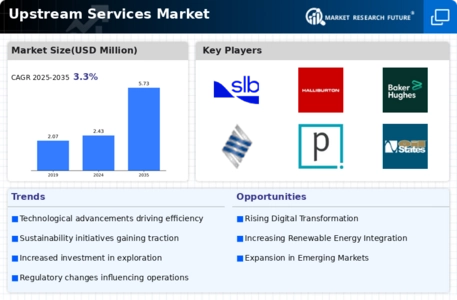Top Industry Leaders in the Upstream Services Market

*Disclaimer: List of key companies in no particular order
Latest Company Updates:
Competitive Landscape of Upstream Services Market: Navigating a Dynamic Terrain
The upstream services market, encompassing exploration, drilling, production, and processing activities for oil and gas reserves, pulsates with fierce competition. A complex interplay of established giants, nimble niche players, and disruptive innovators defines this landscape, constantly shifting the ground beneath actors' feet. Understanding these dynamics through key player strategies, market share analysis factors, and emerging trends is crucial for any company seeking to secure a foothold and thrive.
Key Player Strategies:
Industry Titans: Majors like Schlumberger, Halliburton, and Baker Hughes hold significant market share through their diversified service portfolios, global reach, and technological prowess. They prioritize strategic acquisitions, partnerships with national oil companies (NOCs), and investments in research & development to maintain their dominant positions.
Niche Specialists: Companies like Weatherford and National Oilwell Varco excel in specific segments like drilling and well completion. They leverage deep domain expertise, operational efficiency, and cost-competitiveness to carve out profitable niches within the larger market.
Technology Startups: Agile innovators are emerging with data analytics, automation, and artificial intelligence solutions, aiming to optimize existing processes and unlock new operational efficiencies. Their disruptive focus attracts venture capital and potential partnerships, challenging established players to adapt or fall behind.
Market Share Analysis Factors:
Geographic Footprint: Presence in high-growth regions like the Middle East, Asia Pacific, and Latin America plays a crucial role. Companies with strong regional partnerships and infrastructure are better positioned to capitalize on local opportunities.
Service Portfolio Breadth and Depth: Offering a comprehensive range of services across the upstream value chain caters to diverse client needs and fosters long-term loyalty. However, specialization in critical segments can also be a winning strategy.
Technological Innovation: Continuous investment in cutting-edge technologies like robotics, remote monitoring, and digital twins is vital for cost optimization, safety improvement, and environmental sustainability. Companies demonstrating leadership in these areas attract premium contracts and gain a competitive edge.
Cost Efficiency and Operational Excellence: Streamlining operations, optimizing supply chains, and adopting lean manufacturing practices are key to profitability in a cost-sensitive market. Companies that demonstrate agility and adaptability in their operations have a distinct advantage.
New and Emerging Trends:
Focus on sustainability: Growing environmental concerns are driving demand for solutions that minimize upstream activities' environmental footprint. Carbon capture and storage, methane emission reduction technologies, and integration of renewable energy sources are gaining traction.
Digitalization and Automation: The adoption of artificial intelligence, big data analytics, and automation promises significant gains in operational efficiency, safety, and predictive maintenance. Companies investing in these areas will be well-positioned to capture the potential of the digital oilfield.
Collaboration and Partnerships: To address complex challenges and leverage diverse expertise, players are increasingly forming strategic partnerships across the value chain. Integration with technology providers, service companies, and even competitors is becoming commonplace.
Focus on Local Content and Talent Development: Meeting local content requirements and developing skilled workforces are crucial for long-term success in certain regions. Companies proactively engaging with local communities and governments are building goodwill and securing access to critical resources.
Overall Competitive Scenario:
The upstream services market remains fiercely competitive, characterized by constant innovation, consolidation, and disruption. Established players are being challenged by nimble specialists and technologically savvy startups. Success hinges on adapting to emerging trends, embracing collaboration, and prioritizing sustainability. Companies that can demonstrate agility, operational excellence, and a forward-looking vision are best positioned to navigate this dynamic landscape and secure a dominant position in the years to come.
Schlumberger Limited (U.S.)
• Dec 19, 2023: Announced a partnership with Microsoft to develop AI-powered solutions for oil and gas exploration and production. (Source: Schlumberger press release)
Halliburton (U.S.)
• Dec 12, 2023: Launched its Landmark™ EarthScience 365 cloud-based reservoir characterization platform. (Source: Halliburton press release)
Baker Hughes Incorporated (U.S.)
• Dec 22, 2023: Completed the acquisition of Newpark Resources, expanding its well completion and production services portfolio. (Source: Baker Hughes press release)
Petrofac Limited (Jersey)
• Dec 06, 2023: Awarded a contract by bp for the FEED (front-end engineering design) of the Margarita 7 offshore gas development project in Mexico. (Source: Petrofac press release)
Top listed global companies in the industry are:
Schlumberger Limited (U.S.), Halliburton (U.S.), Baker Hughes Incorporated (U.S.), Petrofac Limited (Jersey), Weatherford (U.S.), TECHNIP (U.K), China Oilfield Services Limited (China), Transocean Ltd. (Switzerland), Flour Corporation (U.S.), and Saipem S.p.A. (Italy), GE Oil & Gas (U.S.)

